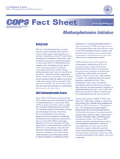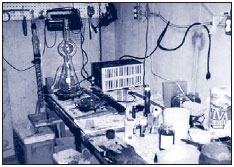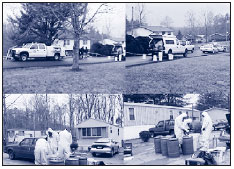 |
Winter 2006 |
 |
|

COPS Office releases tools for combating meth
Tools for Combating Meth contains practical guidebooks that address issues such as clandestine drug labs, drug dealing in open-air markets and privately owned apartment complexes, identity theft, and prescription fraud. Other publications included in the toolkit address the environmental dangers involved in methamphetamine production and provide best practices for combating meth that have been gathered from previous meth programs funded by the U.S. Department of Justice Office of Community Oriented Policing Services (the COPS Office). Several of these publications are profiled in this issue of Justice Resource Update.
Tools for Combating Meth
 Evaluating the Meth Initiative Evaluating the Meth Initiative
Clandestine drug laboratories are used in the illicit production of illegal drugs, most often methamphetamine. The COPS Office?s Methamphetamine Initiative provides Federal grant funding to State, local, and tribal law enforcement agencies to assist in the eradication of clandestine laboratories, including the seizure of those laboratories and the removal, storage, and disposal of hazardous chemical materials, equipment, and waste products retrieved from laboratory sites.
This COPS-funded evaluation of the Initiative, conducted by the Institute for Law and Justice and 21st Century Solutions, evaluates the COPS Office?s first six methamphetamine grants. The COPS Office provided funding to six agencies (Phoenix, AZ; Salt Lake City, UT; Dallas, TX; Oklahoma City, OK; Little Rock, AR; Minneapolis, MN) to combat the production, distribution, and use of meth. This evaluation focuses on the histories of the meth problems in these cities and includes detailed process evaluations of each grant?s implementation. This report provides insight into the ways in which these agencies responded to their meth problems and should be of interest to those dealing with similar drug problems in their jurisdictions.
An Evaluation of the COPS Office Methamphetamine Initiative, 293 pages
New fact sheets focus on methamphetamine
 |
|
* Photo taken from Meth = Death CD
|
The COPS Office has two new meth-related fact sheets. The first discusses the COPS Office?s methamphetamine funding, which supports enforcement, training, and lab cleanup activities nationwide. Since 1998, COPS has invested more than $385 million in combating the spread of meth.
Methamphetamine Initiative, 2 pages
The second fact sheet focuses on the detrimental environmental effects of clandestine drug laboratories and drug cleanup efforts. The COPS Office endeavors to minimize environmental harm that may occur as a result of federally funded activities. Therefore, it conducts regular environmental assessments for the Methamphetamine Initiative. The most recent assessment (2003) concluded that any potential environmental damage resulting from activities funded under the Initiative were mitigated by the reduction of the risks associated with illegal production of methamphetamine and improper storage and disposal of materials and waste by clandestine labs.
Fact Sheet on Environmental Assessment for the Methamphetamine Initiative, 2 pages
Clandestine drug labs
This guide addresses the problem of clandestine drug labs. Offenders manufacture a variety of illicit drugs in such labs, including methamphetamine, amphetamines, MDMA (ecstasy), methcathinone, PCP, LSD, and fentanyl; however, methamphetamine accounts for 80 to 90 percent of the labs? total drug production. Accordingly, clandestine drug labs are closely tied to other problems associated with methamphetamine abuse.
Clandestine Drug Labs, Problem-Oriented Guides for Police Series, No. 16, 68 pages
Combating methamphetamine laboratories and abuse 
Part of the COPS Innovations series,this document briefly summarizes the findings of the evaluation of the Meth Initiative and suggests ways that agencies can better deal with their own methamphetamine problems through a discussion of the COPS Office?s Problem-Oriented Policing Guide to Clandestine Laboratories. It evaluates the COPS Office?s first six meth grants and finds that these grants encourage law enforcement agencies
to respond to meth problems with advanced technologies and creative problem-solving strategies. Combating Methamphetamine Laboratories and Abuse: Strategies for Success, 16 pages
Drug courts may be best hope for combating methamphetamine
One valuable tool for fighting methamphetamine addiction and trafficking is the drug court, which combines intensive drug rehabilitation services for addicts with the legal requirement to complete treatment. Drug courts also take account of the increasing number of children exposed to abuse or neglect by
meth-addicted parents or endangered by meth labs in their homes. This BJA publication describes the role of the drug court and emphasizes the importance of keeping the client engaged in treatment, providing effective treatment protocols, and reintegrating the addict into the community. It provides examples of exemplary drug court practices and sets forth recommendations for policymakers seeking to reduce recidivism and promote abstinence, reunite families, and enhance public safety in their communities.
Drug Courts: An Effective Strategy for Communities Facing Methamphetamine, 16 pages
Wyoming?s war on meth  |
|
* Photo taken from Meth = Death CD
|
In Wyoming, as in many rural areas of the country, methamphetamine took hold, creating an overnight population of addicts in rural communities that thought drugs were a big-city problem. This BJA Practitioner Perspectives bulletin tells the ongoing story of Wyoming?s ambitious initiative to rid the State of meth. Central to Wyoming?s war on meth was the Governor?s Substance Abuse and Violent Crime Advisory Board established in 1987 and mandated to develop a comprehensive crime and drug control strategy for the State. Armed with public support, the board convinced the State legislature that funds were needed for a comprehensive methamphetamine initiative. It then focused on establishing research-based and proven practices for combating meth. The board?s plan was to establish drug treatment, intervention, and prevention pilot programs throughout the State before devoting long-term assistance to any one initiative.
Wyoming?s Methamphetamine Initiative: The Power of Informed Process (Practitioner Perspectives), 16 pages
Helping meth?s youngest victims
This OVC bulletin describes the health and safety risks faced by children who live in or visit buildings that house clandestine methamphetamine labs. Measures are suggested to respond to children?s mental and physical health issues when law enforcement officers seize meth labs. The experiences of several States that use multidisciplinary teams are offered as examples of promising interventions, and the importance of collaboration among Federal, State, and local agencies to ensure the care and protection of these children is emphasized.
Children at Clandestine Methamphetamine Labs: Helping Meth?s Youngest Victims, 12 pages
* Meth = Death CD?ROM. Photo of an illicit methamphetamine lab is courtesy of Jerrod Wright, Health Educator, Putnam and White Counties, Upper Cumberland Region (Tennessee), Department of Health, and is excerpted from the Meth Education Tool Kit ?Meth = Death,? a CD produced as a collaboration among Wright, the Putnam County Health Department, and Bill Gibson, 13th Judicial District Attorney?s Office,the 13th Judicial District Drug Task Force, and Tennessee Tech University?s Business Media Center.
*Be sure to check the NCJRS Web site (http://www.ncjrs.gov) for announcements of forthcoming publications and resources.
| 
